英语教研活动记录1
- 格式:doc
- 大小:43.50 KB
- 文档页数:6
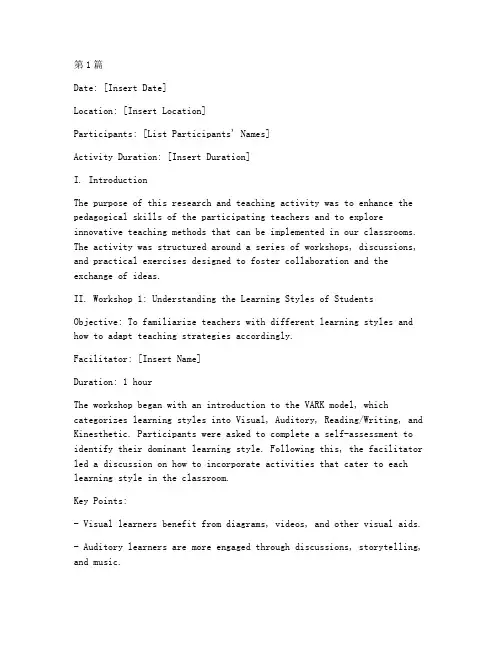
第1篇Date: [Insert Date]Location: [Insert Location]Participants: [List Participants' Names]Activity Duration: [Insert Duration]I. IntroductionThe purpose of this research and teaching activity was to enhance the pedagogical skills of the participating teachers and to explore innovative teaching methods that can be implemented in our classrooms. The activity was structured around a series of workshops, discussions, and practical exercises designed to foster collaboration and the exchange of ideas.II. Workshop 1: Understanding the Learning Styles of StudentsObjective: To familiarize teachers with different learning styles and how to adapt teaching strategies accordingly.Facilitator: [Insert Name]Duration: 1 hourThe workshop began with an introduction to the VARK model, which categorizes learning styles into Visual, Auditory, Reading/Writing, and Kinesthetic. Participants were asked to complete a self-assessment to identify their dominant learning style. Following this, the facilitator led a discussion on how to incorporate activities that cater to each learning style in the classroom.Key Points:- Visual learners benefit from diagrams, videos, and other visual aids.- Auditory learners are more engaged through discussions, storytelling, and music.- Reading/Writing learners prefer written instructions and reflective tasks.- Kinesthetic learners learn best through hands-on activities and physical movement.III. Workshop 2: Technology Integration in the ClassroomObjective: To explore the use of technology as a tool for enhancing student engagement and learning outcomes.Facilitator: [Insert Name]Duration: 1.5 hoursThis workshop focused on integrating various digital tools into lesson plans. Participants were introduced to platforms such as Google Classroom, Kahoot!, and Flipgrid. They also learned about the importance of digital citizenship and how to ensure the safe use of technology.Key Points:- Google Classroom allows for easy organization and communication with students.- Kahoot! can be used for quick formative assessments and review games.- Flipgrid enables students to share their thoughts and reflections through video.IV. Group Discussion: Challenges and Solutions in TeachingObjective: To share experiences and brainstorm solutions to common teaching challenges.Duration: 2 hoursParticipants were divided into small groups and were given the task of discussing specific challenges they face in their classrooms. Each group was then asked to present their findings to the larger group, offering potential solutions and best practices.Challenges Discussed:- Student motivation and engagement- Classroom management- Differentiation of instruction- Assessment strategiesV. Practical Exercise: Designing an Interactive Lesson PlanObjective: To apply the concepts learned in the workshops to create an interactive lesson plan.Duration: 2 hoursParticipants were provided with a topic and were tasked with designing a lesson plan that incorporates at least two of the digital tools discussed in the previous workshop. They were encouraged to think creatively and to consider the learning styles of their students.Key Points:- The lesson plans should include clear objectives and activities that cater to various learning styles.- Technology should be used as a tool to enhance learning, not as the main focus of the lesson.- Assessment should be formative and embedded within the lesson.VI. Reflection and FeedbackObjective: To reflect on the day's activities and provide feedback for future improvement.Duration: 30 minutesParticipants were asked to reflect on the day's activities and share their thoughts on what they found most beneficial. They were also encouraged to provide feedback on the workshop structure and content.Feedback Received:- The workshops were engaging and provided practical tools that can be used in the classroom.- The group discussions were valuable for sharing experiences and learning from each other.- The practical exercise was a good opportunity to apply the concepts learned.VII. ConclusionThe research and teaching activity was a resounding success, providing participants with valuable insights and resources to enhance their teaching practices. The collaborative environment allowed for the exchange of ideas and the development of innovative approaches to teaching and learning. We look forward to implementing these strategies in our classrooms and continuing to grow as educators.VIII. Action Plan for Future Activities- Organize regular workshops on emerging educational technologies.- Establish a peer mentoring program to support new teachers.- Conduct regular feedback sessions to assess the impact of the implemented strategies.- Explore the possibility of guest speaker sessions to expose teachers to diverse perspectives and practices.IX. Sign-offThis research and teaching activity record has been prepared by [Insert Your Name], [Insert Your Position], [Insert Your Institution]. Any questions or comments regarding this document should be directed to [Insert Contact Information].第2篇Date: [Insert Date]Location: [Insert Location]Attendees: [Insert Names of Attendees]Facilitator: [Insert Name of Facilitator]Introduction:The purpose of this teaching research activity was to explore innovative teaching methods, share best practices, and enhance the overall quality of education within our school community. The activity focused on the integration of technology in the classroom, student engagement strategies, and collaborative learning approaches.I. Opening RemarksThe facilitator, [Facilitator's Name], welcomed all participants to the teaching research activity. He emphasized the importance of continuous professional development and the need to adapt to the evolving educational landscape. The facilitator also outlined the agenda for the day, which included a series of workshops, presentations, and group discussions.II. Workshop 1: Integrating Technology in the Classroom1. Presentation by [Presenter's Name]:[Presenter's Name] provided an insightful presentation on the benefits of integrating technology in the classroom. He discussed various tools and resources available to educators, such as interactive whiteboards, educational apps, and online platforms. The presentation alsohighlighted the importance of digital literacy and the need to prepare students for the digital age.2. Group Discussion:The participants engaged in a group discussion to share their experiences with technology integration. They discussed the challenges they faced, the successes they achieved, and the strategies they employed to effectively incorporate technology into their teachingpractices. The group also identified areas where further support and resources were needed.III. Workshop 2: Student Engagement Strategies1. Presentation by [Presenter's Name]:[Presenter's Name] presented various student engagement strategies that can be implemented in the classroom. These strategies included interactive learning activities, collaborative projects, and real-world connections. The presentation emphasized the importance of understanding student interests and creating a supportive learning environment.2. Group Activity:The participants were divided into small groups to brainstorm and develop their own student engagement activities. Each group shared their ideas with the larger group, and the facilitator provided feedback and suggestions for improvement.IV. Workshop 3: Collaborative Learning Approaches1. Presentation by [Presenter's Name]:[Presenter's Name] discussed the benefits of collaborative learning and provided examples of successful collaborative activities. The presentation focused on the importance of communication, teamwork, and mutual respect in collaborative settings.2. Group Discussion:The participants engaged in a group discussion to share their experiences with collaborative learning. They discussed the challenges they encountered, the benefits they observed, and the strategies they used to promote collaboration among students.V. Group PresentationsEach group presented their student engagement activities and collaborative learning strategies to the rest of the participants. The presentations were followed by feedback and suggestions from the othergroups. The facilitator provided additional insights and guidance to enhance the proposed activities.VI. Closing RemarksThe facilitator, [Facilitator's Name], summarized the key takeaways from the teaching research activity. He encouraged the participants to implement the new strategies and share their experiences with their colleagues. The facilitator also mentioned the availability of ongoing support and resources for educators interested in further developing their teaching practices.VII. Action Plan1. [Participant's Name]: Implement a technology-based project in their classroom and document the process and outcomes.2. [Participant's Name]: Incorporate a collaborative learning activity into their lesson plans and evaluate its effectiveness.3. [Participant's Name]: Share their experiences with technology integration with their colleagues during the next staff meeting.Conclusion:The teaching research activity was a valuable opportunity for educators to learn from each other and explore new teaching methods. The participants left the session with a wealth of ideas and resources to enhance their teaching practices. The collaborative nature of the event fostered a sense of community and support among the educators, and the shared commitment to continuous improvement in education was evident throughout the day.Total Duration: [Insert Total Duration of the Activity]Total Participants: [Insert Total Number of Participants]Feedback: [Insert Feedback Received from Participants]第3篇Date: [Insert Date]Location: [Insert Location]Participants: [List of Participants]Facilitator: [Name of Facilitator]Objective: To enhance teaching strategies and student engagement through collaborative research and discussion.I. IntroductionThe purpose of this teaching research activity was to bring together a diverse group of educators to discuss effective teaching strategies and share insights on how to improve student engagement. The activity aimed to foster a collaborative environment where participants could learn from each other's experiences and expertise.II. Agenda1. Opening Remarks2. Sharing of Best Practices3. Group Discussions4. Interactive Workshops5. Reflection and Feedback6. Closing RemarksIII. Opening RemarksThe facilitator began the session by welcoming all participants and providing a brief overview of the day's agenda. Emphasizing the importance of collaboration and open communication, the facilitator encouraged everyone to actively participate and contribute their ideas throughout the activity.IV. Sharing of Best PracticesThe first segment of the activity involved sharing of best practices among the participants. Each educator presented a brief overview of ateaching strategy or method that had been successful in their classrooms. The following were some of the strategies shared:1. Inquiry-Based Learning: Encouraging students to ask questions and explore topics in depth, fostering critical thinking skills.2. Technology Integration: Utilizing educational technology tools to enhance student engagement and provide interactive learning experiences.3. Project-Based Learning: Assigning projects that require students to apply their knowledge in real-world scenarios, promoting practicalskills development.4. Collaborative Learning: Encouraging students to work in groups to solve problems and share ideas, enhancing communication and teamwork skills.5. Differentiated Instruction: Tailoring instruction to meet the individual needs of students, ensuring that all learners are challenged and supported.V. Group DiscussionsAfter the sharing of best practices, participants were divided intosmall groups to discuss the following topics:1. Challenges in Implementing New Teaching Strategies2. Strategies for Overcoming Barriers to Student Engagement3. The Role of Technology in the Classroom4. The Importance of Continuous Professional DevelopmentEach group engaged in lively discussions, sharing their experiences and insights. The following points were highlighted during these discussions:1. Time Constraints: Many educators mentioned that implementing new teaching strategies can be challenging due to time constraints and the need to cover the curriculum.2. Student Motivation: Encouraging student motivation is crucial for successful student engagement. Educators discussed various methods, such as setting clear expectations, providing positive feedback, and creating a supportive classroom environment.3. Technological Literacy: Educators agreed that it is essential to stay updated with the latest technological tools and integrate them effectively into teaching practices.4. Continuous Professional Development: Continuous learning and development are essential for educators to keep up with the evolving educational landscape and provide the best possible learning experiences for their students.VI. Interactive WorkshopsTo further explore the discussed topics, participants engaged in interactive workshops. These workshops aimed to provide hands-on experience and practical skills development. The following workshops were conducted:1. Designing Inquiry-Based Learning Activities2. Using Educational Technology Tools in the Classroom3. Implementing Project-Based Learning4. Developing Differentiated Instruction PlansParticipants were encouraged to actively participate in the workshops, asking questions and sharing their ideas with others.VII. Reflection and FeedbackAfter the workshops, participants reflected on their learning experiences and provided feedback on the activity. The following points were highlighted:1. The activity provided valuable insights into various teaching strategies and methods.2. The opportunity for collaborative learning and sharing experiences was highly beneficial.3. The workshops were practical and helpful in developing skills that can be applied in the classroom.4. The facilitator's guidance and support throughout the activity were commendable.VIII. Closing RemarksThe facilitator concluded the session by summarizing the key takeaways from the activity and expressing gratitude to all participants for their active involvement and contributions. The facilitator emphasized the importance of implementing the discussed strategies and techniques in our classrooms to improve student engagement and achieve better learning outcomes.IX. Next StepsParticipants were encouraged to continue the collaborative learning process by joining a virtual community of practice or attending future teaching research activities. The facilitator also provided resources and materials that could be utilized to further enhance their teaching practices.Overall, the teaching research activity was a successful endeavor that provided educators with valuable insights and practical skills to improve their teaching methods and student engagement. The collaborative nature of the activity fostered a sense of community and support among the participants, ensuring that the learning experience extended beyond the day's session.。
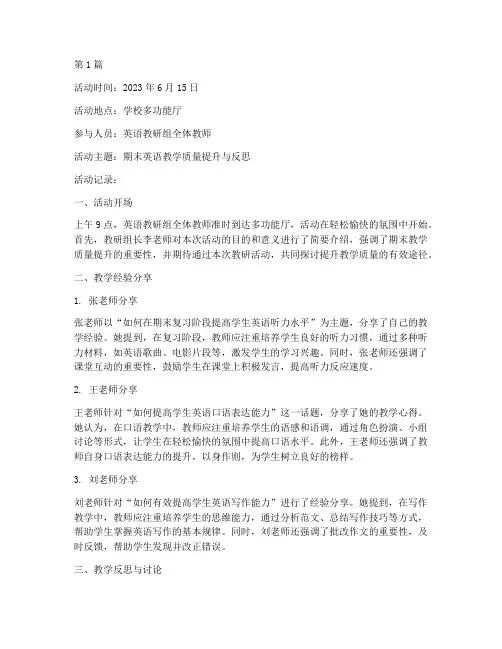
第1篇活动时间:2023年6月15日活动地点:学校多功能厅参与人员:英语教研组全体教师活动主题:期末英语教学质量提升与反思活动记录:一、活动开场上午9点,英语教研组全体教师准时到达多功能厅,活动在轻松愉快的氛围中开始。
首先,教研组长李老师对本次活动的目的和意义进行了简要介绍,强调了期末教学质量提升的重要性,并期待通过本次教研活动,共同探讨提升教学质量的有效途径。
二、教学经验分享1. 张老师分享张老师以“如何在期末复习阶段提高学生英语听力水平”为主题,分享了自己的教学经验。
她提到,在复习阶段,教师应注重培养学生良好的听力习惯,通过多种听力材料,如英语歌曲、电影片段等,激发学生的学习兴趣。
同时,张老师还强调了课堂互动的重要性,鼓励学生在课堂上积极发言,提高听力反应速度。
2. 王老师分享王老师针对“如何提高学生英语口语表达能力”这一话题,分享了她的教学心得。
她认为,在口语教学中,教师应注重培养学生的语感和语调,通过角色扮演、小组讨论等形式,让学生在轻松愉快的氛围中提高口语水平。
此外,王老师还强调了教师自身口语表达能力的提升,以身作则,为学生树立良好的榜样。
3. 刘老师分享刘老师针对“如何有效提高学生英语写作能力”进行了经验分享。
她提到,在写作教学中,教师应注重培养学生的思维能力,通过分析范文、总结写作技巧等方式,帮助学生掌握英语写作的基本规律。
同时,刘老师还强调了批改作文的重要性,及时反馈,帮助学生发现并改正错误。
三、教学反思与讨论在经验分享环节结束后,全体教师针对期末教学进行了反思与讨论。
大家纷纷结合自身教学实践,提出了以下问题:1. 如何在短时间内提高学生的英语成绩?2. 如何激发学生的学习兴趣,提高课堂参与度?3. 如何针对不同层次的学生,制定个性化的教学方案?4. 如何提高教师自身的专业素养,更好地服务于教学?针对这些问题,老师们进行了深入的探讨,并提出了以下建议:1. 制定科学合理的复习计划,确保复习内容全面、系统。
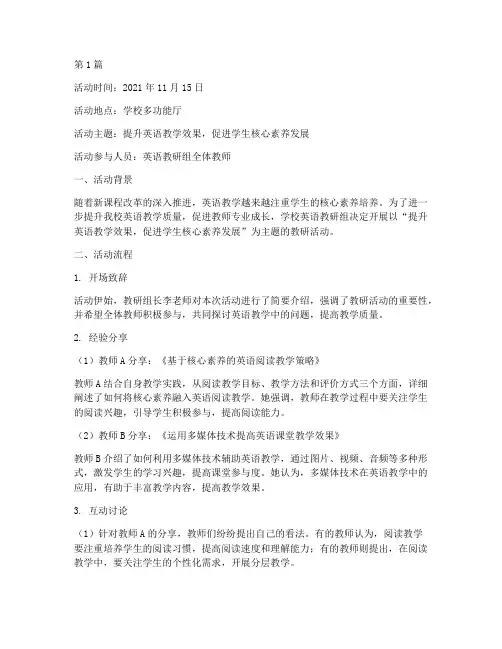
第1篇活动时间:2021年11月15日活动地点:学校多功能厅活动主题:提升英语教学效果,促进学生核心素养发展活动参与人员:英语教研组全体教师一、活动背景随着新课程改革的深入推进,英语教学越来越注重学生的核心素养培养。
为了进一步提升我校英语教学质量,促进教师专业成长,学校英语教研组决定开展以“提升英语教学效果,促进学生核心素养发展”为主题的教研活动。
二、活动流程1. 开场致辞活动伊始,教研组长李老师对本次活动进行了简要介绍,强调了教研活动的重要性,并希望全体教师积极参与,共同探讨英语教学中的问题,提高教学质量。
2. 经验分享(1)教师A分享:《基于核心素养的英语阅读教学策略》教师A结合自身教学实践,从阅读教学目标、教学方法和评价方式三个方面,详细阐述了如何将核心素养融入英语阅读教学。
她强调,教师在教学过程中要关注学生的阅读兴趣,引导学生积极参与,提高阅读能力。
(2)教师B分享:《运用多媒体技术提高英语课堂教学效果》教师B介绍了如何利用多媒体技术辅助英语教学,通过图片、视频、音频等多种形式,激发学生的学习兴趣,提高课堂参与度。
她认为,多媒体技术在英语教学中的应用,有助于丰富教学内容,提高教学效果。
3. 互动讨论(1)针对教师A的分享,教师们纷纷提出自己的看法。
有的教师认为,阅读教学要注重培养学生的阅读习惯,提高阅读速度和理解能力;有的教师则提出,在阅读教学中,要关注学生的个性化需求,开展分层教学。
(2)针对教师B的分享,教师们就多媒体技术的应用展开了热烈讨论。
有的教师表示,多媒体技术确实有助于提高课堂效果,但也要注意避免过度依赖,以免影响学生的自主学习能力。
4. 总结与反思教研组长李老师对本次活动进行了总结,她指出,本次教研活动取得了圆满成功,教师们在交流中碰撞出许多有益的教学思路。
她强调,英语教学要关注学生的核心素养,注重培养学生的语言能力、文化意识和思维品质。
同时,教师要积极探索新的教学方法,提高教学效果。
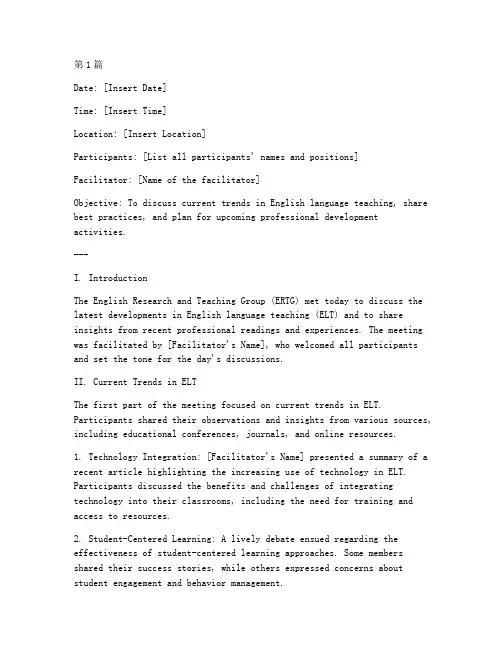
第1篇Date: [Insert Date]Time: [Insert Time]Location: [Insert Location]Participants: [List all participants' names and positions]Facilitator: [Name of the facilitator]Objective: To discuss current trends in English language teaching, share best practices, and plan for upcoming professional developmentactivities.---I. IntroductionThe English Research and Teaching Group (ERTG) met today to discuss the latest developments in English language teaching (ELT) and to share insights from recent professional readings and experiences. The meeting was facilitated by [Facilitator's Name], who welcomed all participants and set the tone for the day's discussions.II. Current Trends in ELTThe first part of the meeting focused on current trends in ELT. Participants shared their observations and insights from various sources, including educational conferences, journals, and online resources.1. Technology Integration: [Facilitator's Name] presented a summary of a recent article highlighting the increasing use of technology in ELT. Participants discussed the benefits and challenges of integrating technology into their classrooms, including the need for training and access to resources.2. Student-Centered Learning: A lively debate ensued regarding the effectiveness of student-centered learning approaches. Some members shared their success stories, while others expressed concerns about student engagement and behavior management.3. Globalization and Multilingualism: The group acknowledged the growing importance of multilingualism in the global context. Discussion focused on how to prepare students for the complexities of living in a multilingual world.III. Best Practices SharingFollowing the trend discussion, participants engaged in a round-table sharing of best practices. Each member presented a technique or strategy that they have found particularly effective in their teaching.1. [Participant's Name]: Shared a method for incorporating peer feedback into writing assignments, which has significantly improved students' writing skills.2. [Participant's Name]: Discussed the use of authentic materials, such as news articles and videos, to engage students and make lessons more relevant.3. [Participant's Name]: Explained a game-based learning approach that has been successful in motivating students to practice speaking and listening skills.IV. Case Studies and AnalysisTo further deepen understanding and practical application, the group analyzed several case studies provided by the facilitator. These case studies covered a range of ELT scenarios, including classroom management, curriculum design, and assessment strategies.1. Case Study 1: The group discussed a situation where a teacher was struggling to manage a diverse class with varying language proficiency levels. Suggestions included differentiated instruction and the use of cooperative learning activities.2. Case Study 2: Participants debated the effectiveness of astandardized test used to assess students' language proficiency. The discussion highlighted the importance of alternative assessment methods and the need for a balanced approach.V. Upcoming Professional Development ActivitiesThe final part of the meeting focused on planning upcoming professional development activities. Participants proposed various ideas, which were then discussed and refined.1. Workshop on Technology in ELT: A half-day workshop will be organized to explore the use of technology in ELT, including hands-on activities and best practice sharing.2. Guest Speaker Series: The group agreed to invite a renowned ELT expert to speak on the topic of student-centered learning. The eventwill be open to all faculty members.3. Curriculum Development Workshop: A collaborative project to develop a new curriculum for intermediate-level students will begin in the next month. Participants will be involved in designing lesson plans, activities, and assessment tools.VI. ConclusionThe meeting concluded with a summary of the key points discussed and an agreement on the next steps for each proposed activity. Participants expressed their gratitude to the facilitator for organizing the meeting and acknowledged the value of collaborative learning in enhancing their professional growth.VII. Action Items- [Facilitator's Name] to coordinate with the IT department for the technology workshop.- [Participant's Name] to prepare the workshop materials for the guest speaker series.- [Participant's Name] to lead the curriculum development project.Date for Next Meeting: [Insert Date]---This record provides a comprehensive overview of the ERTG's research activity, showcasing the group's commitment to staying informed about current trends in ELT and to fostering a culture of continuous professional development.第2篇Date: March 15, 2023Location: Conference Room 301, Main BuildingTime: 2:00 PM - 5:00 PMParticipants:- Mr. John Smith, Head of English Department- Ms. Jane Doe, Senior English Teacher- Mr. Michael Chen, Junior English Teacher- Ms. Sarah Kim, ESL Teacher- Ms. Emily Zhang, Curriculum Developer- Ms. Lily Wu, Learning Support SpecialistObjective:The objective of this教研活动 was to discuss and evaluate the current state of English language teaching in our school, identify areas for improvement, and develop strategies to enhance the overall learning experience for our students.Agenda:1. Welcome and Opening Remarks2. Current State of English Language Teaching3. Identifying Areas for Improvement4. Strategies for Enhancing Learning5. Feedback and Recommendations6. Conclusion and Next Steps1. Welcome and Opening RemarksMr. John Smith, the Head of English Department, welcomed allparticipants and provided an overview of the purpose of the教研活动. He emphasized the importance of continuous improvement in teaching methods and student learning outcomes.2. Current State of English Language TeachingMs. Jane Doe, a senior English teacher, presented an overview of the current state of English language teaching in our school. Shehighlighted the strengths, such as high student engagement and positive feedback from students, but also pointed out areas of concern, such as inconsistent vocabulary coverage and lack of personalized learning opportunities.3. Identifying Areas for ImprovementThe group engaged in a lively discussion to identify specific areas where improvements could be made. The following points were raised:- Vocabulary Coverage: There was a consensus that the current curriculum could benefit from a more structured approach to vocabulary teaching, ensuring that all students are exposed to a broad and relevant range of words.- Personalized Learning: The need for more personalized learning experiences was emphasized, especially for students with varying levels of proficiency. This could include differentiated assignments and individualized feedback.- Technology Integration: The group agreed that integrating technology into the classroom could enhance student engagement and provide additional learning resources.- Assessment Methods: There was a desire to explore alternative assessment methods that could provide a more comprehensive picture of student learning, beyond traditional exams.4. Strategies for Enhancing LearningBased on the identified areas for improvement, the group brainstormed several strategies to enhance learning:- Structured Vocabulary Program: Develop a structured vocabulary program that includes regular vocabulary quizzes, word banks, and vocabulary-rich reading materials.- Differentiated Instruction: Implement differentiated instruction techniques, such as tiered assignments and learning stations, to cater to the diverse needs of students.- Technology Integration: Introduce educational technology tools, such as interactive whiteboards, online learning platforms, and educational apps, to engage students and provide additional learning opportunities.- Alternative Assessment: Explore alternative assessment methods, such as portfolios, presentations, and project-based assessments, to assess student learning in a more holistic manner.5. Feedback and RecommendationsEach participant provided feedback on the proposed strategies and offered recommendations for implementation. The following points were made:- Professional Development: It was suggested that the school provide professional development opportunities for teachers to enhance their skills in differentiated instruction and technology integration.- Resource Allocation: The group recommended allocating additional resources, such as textbooks and educational technology, to support the implementation of the proposed strategies.- Regular Monitoring: It was emphasized that regular monitoring and evaluation of the strategies' effectiveness were crucial to ensure continuous improvement.6. Conclusion and Next StepsMr. John Smith concluded the教研活动 by summarizing the key points discussed and outlining the next steps:- Develop a detailed plan for the structured vocabulary program, including timelines and resources.- Schedule professional development workshops for teachers on differentiated instruction and technology integration.- Allocate additional resources to support the implementation of the proposed strategies.- Set up a monitoring and evaluation framework to assess the effectiveness of the strategies.The教研活动 concluded with a sense of optimism and commitment to enhancing the quality of English language teaching in our school. The group expressed a desire to continue working together and supporting each other in the pursuit of excellence in education.End of Record第3篇Date: March 15, 2023Location: Online Conference PlatformDuration: 2 hoursAttendees: All English teachers from Grade 1 to Grade 12---I. IntroductionThe English Research and Development Group (ERDG) met today to discuss the current state of English language education in our school, to share innovative teaching strategies, and to plan for upcoming projects and professional development opportunities. The meeting was moderated by Ms. Smith, the head of the ERDG.---II. Agenda Items1. Current State of English Language Education2. Innovative Teaching Strategies3. Student Performance Analysis4. Upcoming Projects and Initiatives5. Professional Development Opportunities6. Closing Remarks---III. Current State of English Language EducationMs. Johnson, the English department chair, began the meeting by presenting a comprehensive overview of the current state of English language education in our school. She highlighted the following points:- Student Engagement: The department has noticed a decline in student engagement, particularly in lower grades.- Resource Allocation: There is a need for additional resources, such as textbooks and technology, to enhance the learning experience.- Teacher Training: Continuous professional development is essential to keep up with the latest teaching methodologies.---IV. Innovative Teaching StrategiesMr. Lee, a seasoned English teacher, shared some innovative teaching strategies that he has implemented in his classroom. These included:- Flipped Classroom: Students watch video lessons at home and come to class ready to engage in discussions and activities.- Project-Based Learning: Students work on real-world projects that require them to apply their English skills in a practical context.- Gamification: Incorporating games and competitions into lessons to make learning more enjoyable and motivating.The group discussed these strategies and agreed that they could be adapted to different grade levels and subjects.---V. Student Performance AnalysisMs. Wang, the school's data analyst, presented the results of the recent English proficiency tests. The key findings were:- Overall Improvement: There has been a slight improvement in overall performance, particularly in writing and listening skills.- Grade-Level Differences: There is a significant gap in performance between different grade levels, with lower grades showing more room for improvement.- Gender Differences: There is a notable difference in performance between male and female students, with females generally outperforming males.The group brainstormed potential reasons for these differences and discussed ways to address them.---VI. Upcoming Projects and InitiativesMs. Smith announced the following upcoming projects and initiatives:- English Day: A school-wide event scheduled for May 15th to celebrate the importance of the English language.- Teacher Exchange Program: An opportunity for teachers to observe and learn from colleagues at other schools.- Student Debating Club: A new club that will help students improvetheir public speaking and critical thinking skills.The group discussed the logistics and responsibilities associated with each project.---VII. Professional Development OpportunitiesMs. Brown, the professional development coordinator, informed the group about several upcoming opportunities:- Summer Workshop: A week-long workshop focused on integrating technology into the classroom.- Online Courses: A selection of online courses available to teachers interested in specific areas of English language education.- Webinars: Regular webinars on various teaching topics hosted by renowned educators.The group expressed interest in participating in these opportunities and discussed how to allocate time and resources for professional development.---VIII. Closing RemarksMs. Smith concluded the meeting by summarizing the key points discussed and thanking everyone for their contributions. She emphasized the importance of collaboration and continuous improvement in English language education and encouraged the group to stay engaged and supportive of each other.---IX. Next Steps- Ms. Johnson will prepare a detailed action plan to address the issues raised during the meeting.- Ms. Smith will distribute the meeting minutes and follow-up on the projects and initiatives mentioned.- The ERDG will meet again on June 15, 2023, to review progress and discuss future strategies.End of Meeting---Note: This record has been compiled based on the meeting's minutes and discussions. It is intended to serve as a reference for future planning and improvement in English language education at our school.。
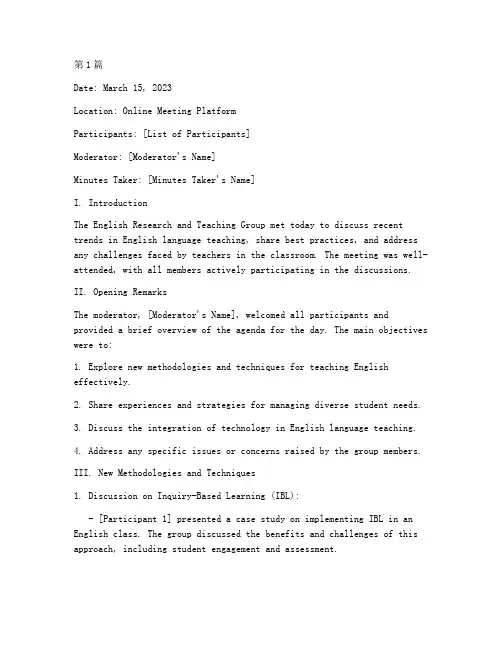
第1篇Date: March 15, 2023Location: Online Meeting PlatformParticipants: [List of Participants]Moderator: [Moderator's Name]Minutes Taker: [Minutes Taker's Name]I. IntroductionThe English Research and Teaching Group met today to discuss recent trends in English language teaching, share best practices, and address any challenges faced by teachers in the classroom. The meeting was well-attended, with all members actively participating in the discussions.II. Opening RemarksThe moderator, [Moderator's Name], welcomed all participants and provided a brief overview of the agenda for the day. The main objectives were to:1. Explore new methodologies and techniques for teaching English effectively.2. Share experiences and strategies for managing diverse student needs.3. Discuss the integration of technology in English language teaching.4. Address any specific issues or concerns raised by the group members.III. New Methodologies and Techniques1. Discussion on Inquiry-Based Learning (IBL):- [Participant 1] presented a case study on implementing IBL in an English class. The group discussed the benefits and challenges of this approach, including student engagement and assessment.- [Participant 2] shared resources and activities that can be used to facilitate IBL in the classroom.- The group agreed that IBL is a valuable approach that promotes critical thinking and autonomy in students.2. Flipped Classroom Model:- [Participant 3] explained the flipped classroom model and its potential to enhance student learning outside the classroom.- Participants discussed the practicalities of implementing this model, such as creating engaging video content and managing time effectively.- The group decided to explore this model further and share their experiences at the next meeting.IV. Managing Diverse Student Needs1. Differentiated Instruction:- [Participant 4] highlighted the importance of differentiated instruction in catering to diverse student needs.- The group shared various strategies for differentiation, such as creating tiered assignments, providing additional support for struggling students, and incorporating varied learning activities.- It was agreed that ongoing assessment and feedback are crucial for successful differentiation.2. English Language Learners (ELLs):- [Participant 5] discussed the challenges faced by ELLs in English language classrooms and shared resources for supporting their learning.- The group agreed on the need for creating a supportive andinclusive classroom environment for ELLs, including providing opportunities for them to practice English and develop confidence.- It was suggested that regular training on cultural sensitivity and language acquisition strategies for ELLs be provided to all teachers.V. Integration of Technology in English Language Teaching1. Digital Resources:- [Participant 6] presented a list of useful digital resources for English language teaching, including online dictionaries, grammar tools, and educational apps.- The group discussed the importance of selecting appropriate resources that align with learning objectives and are accessible to all students.- It was agreed that teachers should be trained on how to effectively integrate technology into their teaching practices.2. Online Learning Platforms:- [Participant 7] shared insights on using online learning platforms for virtual classes and discussed the benefits and limitations of this approach.- The group agreed that online learning platforms can be a valuable tool for providing flexibility and personalized learning experiences, but they also require careful planning and management.- It was suggested that the group explore specific platforms and share their findings at the next meeting.VI. Addressing Specific Issues and Concerns1. Classroom Management:- [Participant 8] raised concerns about classroom management, particularly in large classes.- The group discussed various strategies for effective classroom management, such as setting clear expectations, using positive reinforcement, and maintaining a consistent routine.- It was agreed that teachers should seek support from school administrators when necessary.2. Teacher Development:- [Participant 9] highlighted the importance of ongoing professional development for teachers.- The group discussed the need for regular training sessions, workshops, and networking opportunities to enhance teaching skills and stay updated with the latest trends in English language teaching.- It was proposed that the school organize a series of professional development workshops for teachers in the coming months.VII. ConclusionThe English Research and Teaching Group concluded the meeting with a positive outlook on the future of English language teaching. The discussions today provided valuable insights and practical strategies that can be implemented in the classroom. The group expressed gratitude to all participants for their active involvement and shared commitment to improving English language education.Next Steps:1. Implementing Inquiry-Based Learning (IBL) in classrooms and sharing experiences at the next meeting.2. Exploring the flipped classroom model and its integration into teaching practices.3. Sharing resources and best practices for differentiated instruction and supporting ELLs.4. Investigating online learning platforms and their potential benefits for English language teaching.5. Organizing professional development workshops for teachers to enhance their teaching skills.Meeting Adjourned.第2篇Date: March 15, 2023Location: Online Conference PlatformAttendees:- Mr. John Smith, Head of English Department- Mrs. Lisa Wang, Senior English Teacher- Mr. Mark Zhang, Junior English Teacher- Mrs. Emily Liu, Curriculum Developer- Ms. Grace Chen, Learning Technology Specialist- Ms. Daisy Yang, Student RepresentativeFacilitator: Mrs. Lisa WangAgenda:1. Review of the current English curriculum2. Discussion on effective teaching strategies3. Introduction of new learning technologies4. Evaluation of student performance and feedback5. Future planning and goals---I. Review of the Current English CurriculumMr. John Smith:Good morning, everyone. Let's begin with a review of our current English curriculum. We have been using the XYZ English series for the past three years, and I would like to hear everyone's thoughts on its effectiveness and areas that need improvement.Mrs. Lisa Wang:I agree with John. The XYZ series has its strengths, especially in grammar and vocabulary. However, I feel that the reading sections arenot challenging enough for our advanced students. They often find the texts too simplistic.Mr. Mark Zhang:I concur with Lisa. Additionally, I've noticed that some students struggle with the writing component. The prompts are sometimes too broad, and students are not always clear on what is expected of them.Mrs. Emily Liu:I've been working on developing a more structured approach to writing. We could introduce a series of writing frameworks that guide students through the process, from brainstorming to revision.Discussion:The group discussed various aspects of the curriculum, including the need for more challenging reading materials, clearer writing guidelines, and the integration of technology to enhance learning.---II. Discussion on Effective Teaching StrategiesMs. Grace Chen:I would like to introduce a new learning technology that we could use in our classes. It's called 'Flipped Classroom'. In this approach, students watch instructional videos at home and come to class ready to engage in activities and discussions.Mrs. Lisa Wang:That sounds interesting, Grace. How would this work in our current curriculum?Ms. Grace Chen:We could assign a video on a specific grammar topic or a reading excerpt for students to watch at home. In class, we could then focus on applying that knowledge through interactive exercises and group projects.Mr. Mark Zhang:I think this could be particularly beneficial for students who are shyor reticent to speak in front of the class. They can practice their language skills at home and then feel more confident in class discussions.Mrs. Emily Liu:I also see potential in using this approach for vocabulary building. We could create a series of videos that introduce new words and phrases in context, making them more memorable for students.Discussion:The group enthusiastically discussed the potential of the flipped classroom model and other strategies such as cooperative learning,project-based learning, and formative assessments to enhance student engagement and learning outcomes.---III. Introduction of New Learning TechnologiesMrs. Lisa Wang:Let's talk about integrating new learning technologies into our teaching. We've heard about some great tools like Kahoot!, Quizizz, and Google Classroom. How can we incorporate these into our lessons?Ms. Daisy Yang:I love using Kahoot! for quick formative assessments. It's a fun way to check if students understand the material without making them feel embarrassed if they get the answer wrong.Mr. Mark Zhang:I've started using Quizizz in my classes. It's great for individual practice and also allows me to track student progress over time.Mrs. Emily Liu:Google Classroom has been a game-changer for us. It's a convenient platform for distributing materials, collecting assignments, and providing feedback. Plus, it's accessible from anywhere, which is especially useful for students who are absent.Discussion:The group explored various digital tools and discussed how they could be used to create interactive and engaging lessons, as well as tofacilitate communication and collaboration among students and teachers.---IV. Evaluation of Student Performance and FeedbackMrs. Lisa Wang:Moving on to student performance, I've noticed that our end-of-term assessments have been consistently improving. However, I'm concerned about the feedback we're receiving from students regarding their learning experiences.Ms. Daisy Yang:I've had several students express that they feel overwhelmed by the amount of homework we assign. They find it difficult to manage their time and balance their academic responsibilities.Mr. Mark Zhang:I agree. Perhaps we could offer more flexible deadlines or provide guidance on time management strategies.Mrs. Emily Liu:I think it's also important to consider the diversity of learning styles in our classes. Some students might prefer visual or auditory learning,while others might be more kinesthetic. We could incorporate a variety of teaching methods to cater to these different needs.Discussion:The group discussed ways to address student concerns and improve their learning experiences. They agreed on the importance of providing feedback on feedback, creating a supportive classroom environment, and offering support for students who are struggling.---V. Future Planning and GoalsMr. John Smith:Finally, let's discuss our future planning and goals. What do we want to achieve in the next academic year?Mrs. Lisa Wang:I'd like to see our students become more confident and proficient in English. We should focus on enhancing their reading, writing, speaking, and listening skills.Mr. Mark Zhang:I think it's also crucial to encourage our students to think critically and creatively. We could introduce more debate and discussion activities into our curriculum.Mrs. Emily Liu:I would like to see us incorporate more real-world projects into our lessons. This would help students see the relevance of English in their future careers and personal lives.Ms. Grace Chen:We should also continue to explore and integrate new technologies to keep our lessons fresh and engaging.Discussion:The group outlined specific goals for the upcoming year, including the development of a more comprehensive assessment strategy, the introduction of new teaching methods, and the continuous integration of technology in the classroom.---Conclusion:The English Research and Teaching Group meeting was productive and insightful. The group identified areas for improvement in the current curriculum, explored new teaching strategies and technologies, and set ambitious goals for the future. With continued collaboration and dedication, the English department is poised to provide an exceptional learning experience for all students.第3篇一、活动时间:2021年9月30日二、活动地点:学校会议室三、活动主题:探讨如何提高英语教学质量,促进学生英语能力的全面发展四、活动参与人员:英语教研组成员、学校领导五、活动内容:1. 活动开场活动开始,教研组长简要介绍了本次研讨的主题和目的,强调了提高英语教学质量的重要性,并鼓励大家积极参与讨论。
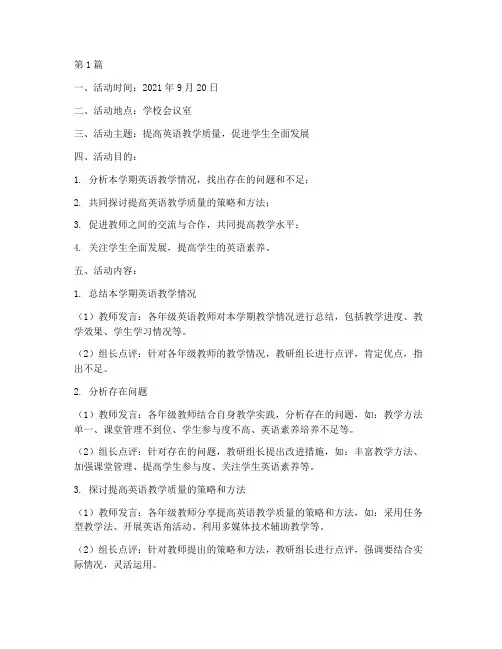
第1篇一、活动时间:2021年9月20日二、活动地点:学校会议室三、活动主题:提高英语教学质量,促进学生全面发展四、活动目的:1. 分析本学期英语教学情况,找出存在的问题和不足;2. 共同探讨提高英语教学质量的策略和方法;3. 促进教师之间的交流与合作,共同提高教学水平;4. 关注学生全面发展,提高学生的英语素养。
五、活动内容:1. 总结本学期英语教学情况(1)教师发言:各年级英语教师对本学期教学情况进行总结,包括教学进度、教学效果、学生学习情况等。
(2)组长点评:针对各年级教师的教学情况,教研组长进行点评,肯定优点,指出不足。
2. 分析存在问题(1)教师发言:各年级教师结合自身教学实践,分析存在的问题,如:教学方法单一、课堂管理不到位、学生参与度不高、英语素养培养不足等。
(2)组长点评:针对存在的问题,教研组长提出改进措施,如:丰富教学方法、加强课堂管理、提高学生参与度、关注学生英语素养等。
3. 探讨提高英语教学质量的策略和方法(1)教师发言:各年级教师分享提高英语教学质量的策略和方法,如:采用任务型教学法、开展英语角活动、利用多媒体技术辅助教学等。
(2)组长点评:针对教师提出的策略和方法,教研组长进行点评,强调要结合实际情况,灵活运用。
4. 关注学生全面发展,提高学生英语素养(1)教师发言:各年级教师讨论如何关注学生全面发展,提高学生英语素养,如:开展课外阅读、组织英语演讲比赛、鼓励学生参加英语角等。
(2)组长点评:针对教师提出的措施,教研组长进行点评,强调要关注学生的个体差异,因材施教。
5. 教学经验交流(1)优秀教师发言:邀请优秀英语教师分享教学经验,如:如何激发学生学习兴趣、如何提高学生英语口语表达能力等。
(2)教师讨论:各年级教师结合自身教学实践,讨论如何借鉴优秀教师的经验,提高自己的教学水平。
六、活动总结本次英语教研组活动圆满结束,达到了预期目的。
通过本次活动,教师们明确了本学期英语教学的重点和难点,提高了对提高英语教学质量的认识,为今后的教学工作奠定了基础。
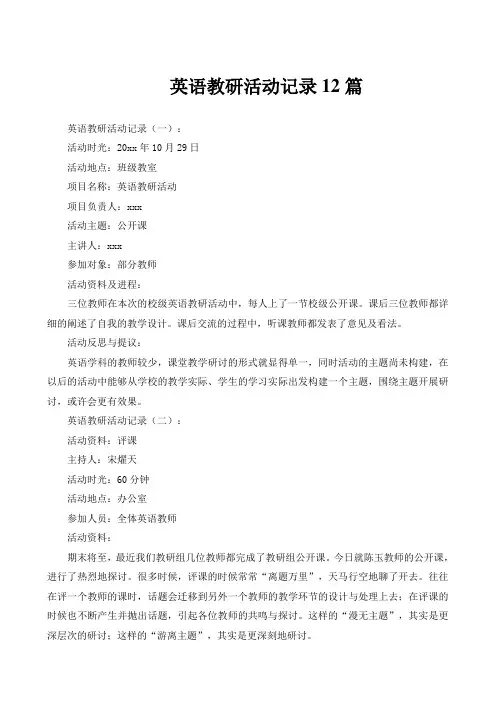
英语教研活动记录12篇英语教研活动记录(一):活动时光:20xx年10月29日活动地点:班级教室项目名称:英语教研活动项目负责人:xxx活动主题:公开课主讲人:xxx参加对象:部分教师活动资料及进程:三位教师在本次的校级英语教研活动中,每人上了一节校级公开课。
课后三位教师都详细的阐述了自我的教学设计。
课后交流的过程中,听课教师都发表了意见及看法。
活动反思与提议:英语学科的教师较少,课堂教学研讨的形式就显得单一,同时活动的主题尚未构建,在以后的活动中能够从学校的教学实际、学生的学习实际出发构建一个主题,围绕主题开展研讨,或许会更有效果。
英语教研活动记录(二):活动资料:评课主持人:宋燿天活动时光:60分钟活动地点:办公室参加人员:全体英语教师活动资料:期末将至,最近我们教研组几位教师都完成了教研组公开课。
今日就陈玉教师的公开课,进行了热烈地探讨。
很多时候,评课的时候常常“离题万里”,天马行空地聊了开去。
往往在评一个教师的课时,话题会迁移到另外一个教师的教学环节的设计与处理上去;在评课的时候也不断产生并抛出话题,引起各位教师的共鸣与探讨。
这样的“漫无主题”,其实是更深层次的研讨;这样的“游离主题”,其实是更深刻地研讨。
叶文教师:这节课设计大胆、新颖,创意十分好。
教师对教材重、难点的把握比较扎实。
陆建华教师:这节课中背景图片都是日常的生活场景,十分有亲切感,能够激发学生学习兴趣。
宋燿天教师:陈教师的教学设计每次都有其独特之处,除了能够显示教师的教学本事,也能够体现教师的教学创新意识和本事。
教学永远没有最好的方法,仅有最适合的方法。
陈教师的教学理念,十分有时代气息。
在课堂教学中十分重视口语练习,着重学生口语交际本事的培养。
坚持下去对学生是十分有好处的。
课堂教学中,难点处理得十分好。
喻丽娟教师:练习题形式十分好,触类旁通,给我自我教学中产生了新的思路。
以后我在自我的教学中也采取类似的方案。
这节课总的比较好,无论教学重、难点的把握,还是教学过程的设计,都比较到位。
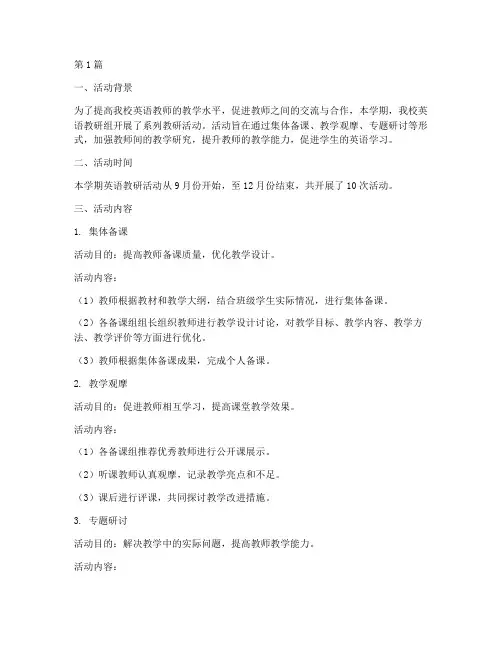
第1篇一、活动背景为了提高我校英语教师的教学水平,促进教师之间的交流与合作,本学期,我校英语教研组开展了系列教研活动。
活动旨在通过集体备课、教学观摩、专题研讨等形式,加强教师间的教学研究,提升教师的教学能力,促进学生的英语学习。
二、活动时间本学期英语教研活动从9月份开始,至12月份结束,共开展了10次活动。
三、活动内容1. 集体备课活动目的:提高教师备课质量,优化教学设计。
活动内容:(1)教师根据教材和教学大纲,结合班级学生实际情况,进行集体备课。
(2)各备课组组长组织教师进行教学设计讨论,对教学目标、教学内容、教学方法、教学评价等方面进行优化。
(3)教师根据集体备课成果,完成个人备课。
2. 教学观摩活动目的:促进教师相互学习,提高课堂教学效果。
活动内容:(1)各备课组推荐优秀教师进行公开课展示。
(2)听课教师认真观摩,记录教学亮点和不足。
(3)课后进行评课,共同探讨教学改进措施。
3. 专题研讨活动目的:解决教学中的实际问题,提高教师教学能力。
活动内容:(1)针对教学中的热点、难点问题,组织教师进行专题研讨。
(2)邀请专家进行讲座,为教师提供理论指导和实践经验。
(3)教师结合自身教学实践,分享教学心得和经验。
四、活动成果1. 教师教学水平得到提高,课堂教学效果明显改善。
2. 教师之间的交流与合作更加紧密,形成了良好的教研氛围。
3. 学生英语学习成绩稳步提升,对英语学习的兴趣和自信心增强。
五、活动总结本学期英语教研活动取得了圆满成功,达到了预期目标。
在今后的工作中,我们将继续深化教研活动,努力提高教师的教学水平和学生的英语学习质量。
具体活动记录如下:1. 9月10日,开展新学期第一次集体备课,针对新教材和教学大纲,优化教学设计。
2. 9月20日,进行第一次教学观摩,展示优秀教师公开课,促进教师相互学习。
3. 10月10日,开展“如何提高学生英语口语表达能力”专题研讨,邀请专家进行讲座。
4. 10月20日,进行第二次教学观摩,教师认真观摩并记录教学亮点和不足。
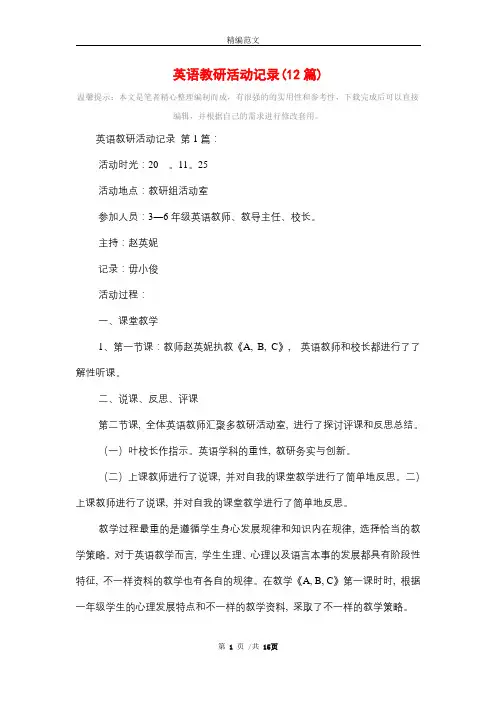
英语教研活动记录(12篇)温馨提示:本文是笔者精心整理编制而成,有很强的的实用性和参考性,下载完成后可以直接编辑,并根据自己的需求进行修改套用。
英语教研活动记录第1篇:活动时光:20__。
11。
25活动地点:教研组活动室参加人员:3―6年级英语教师、教导主任、校长。
主持:赵英妮记录:毋小俊活动过程:一、课堂教学1、第一节课:教师赵英妮执教《A, B, C》, 英语教师和校长都进行了了解性听课。
二、说课、反思、评课第二节课, 全体英语教师汇聚多教研活动室, 进行了探讨评课和反思总结。
(一)叶校长作指示。
英语学科的重性, 教研务实与创新。
(二)上课教师进行了说课, 并对自我的课堂教学进行了简单地反思。
二)上课教师进行了说课, 并对自我的课堂教学进行了简单地反思。
教学过程最重的是遵循学生身心发展规律和知识内在规律, 选择恰当的教学策略。
对于英语教学而言, 学生生理、心理以及语言本事的发展都具有阶段性特征, 不一样资料的教学也有各自的规律。
在教学《A, B, C》第一课时时, 根据一年级学生的心理发展特点和不一样的教学资料, 采取了不一样的教学策略。
一、游戏引领全课在复习导入环节, 我以猜口形的小游戏激发学生学习英语字母的兴趣, 使学生有乐于往下学习的愿望。
二、不一样教学方法贯穿其中在新授课教学环节, 其中一个教学目标就是让学生读准字母Aa 、Bb、Cc 的音。
针对此目标, 我选择了不一样的教学方法。
学习Aa的时候, 用两个小朋友挨在一齐的图来引出Aa的读音, 再让学生反复良好习惯, 体会Aa是怎样发音的。
于是, 学生自然而然的说出先读a, 也能够利用发音方法来回忆、来区分, 这就为今后的学习打下了坚实的基础。
三、教师研讨:(一)、毋小俊:就如何使字母1)、就如何使字母课更加有效?每一环节的落实, 怎样一步一步实施才更加合理等问题, 对赵英妮的字母单词课进行了肯定, 同时也提出了中肯的意见。
使在座的各位教师收获颇丰。
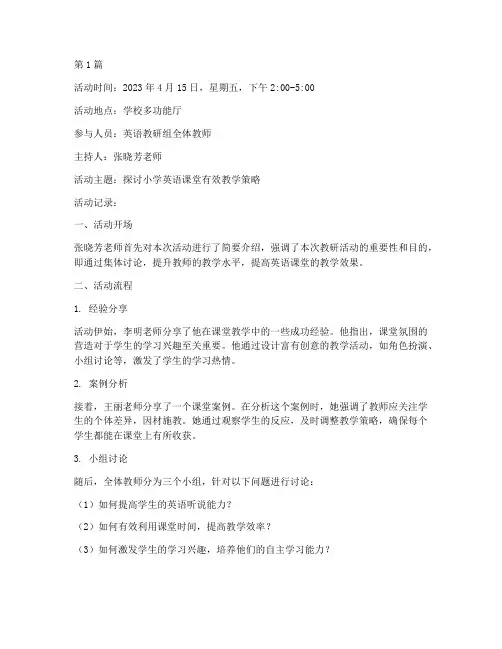
第1篇活动时间:2023年4月15日,星期五,下午2:00-5:00活动地点:学校多功能厅参与人员:英语教研组全体教师主持人:张晓芳老师活动主题:探讨小学英语课堂有效教学策略活动记录:一、活动开场张晓芳老师首先对本次活动进行了简要介绍,强调了本次教研活动的重要性和目的,即通过集体讨论,提升教师的教学水平,提高英语课堂的教学效果。
二、活动流程1. 经验分享活动伊始,李明老师分享了他在课堂教学中的一些成功经验。
他指出,课堂氛围的营造对于学生的学习兴趣至关重要。
他通过设计富有创意的教学活动,如角色扮演、小组讨论等,激发了学生的学习热情。
2. 案例分析接着,王丽老师分享了一个课堂案例。
在分析这个案例时,她强调了教师应关注学生的个体差异,因材施教。
她通过观察学生的反应,及时调整教学策略,确保每个学生都能在课堂上有所收获。
3. 小组讨论随后,全体教师分为三个小组,针对以下问题进行讨论:(1)如何提高学生的英语听说能力?(2)如何有效利用课堂时间,提高教学效率?(3)如何激发学生的学习兴趣,培养他们的自主学习能力?在讨论过程中,老师们各抒己见,分享了自己的教学心得。
经过一番热烈的讨论,各组分别提出了以下建议:(1)提高学生的英语听说能力:- 创设真实的语言环境,鼓励学生在课堂上多开口说英语;- 开展丰富多彩的课外活动,如英语角、英语演讲比赛等;- 利用多媒体技术,如视频、音频等,丰富教学内容。
(2)有效利用课堂时间,提高教学效率:- 制定详细的教学计划,合理安排教学内容;- 优化教学环节,如减少不必要的讲解,增加互动环节;- 关注学生的反馈,及时调整教学策略。
(3)激发学生的学习兴趣,培养自主学习能力:- 创设有趣的教学情境,让学生在轻松愉快的氛围中学习;- 鼓励学生参与课堂活动,发挥他们的主观能动性;- 培养学生的自我管理能力,让他们学会自主学习。
4. 总结与反思最后,张晓芳老师对本次教研活动进行了总结。
她肯定了老师们在讨论中的积极参与和提出的宝贵建议,并强调以下几点:- 教师应不断提高自身的专业素养,关注学生的学习需求;- 注重课堂氛围的营造,激发学生的学习兴趣;- 创新教学方法,提高教学效率。
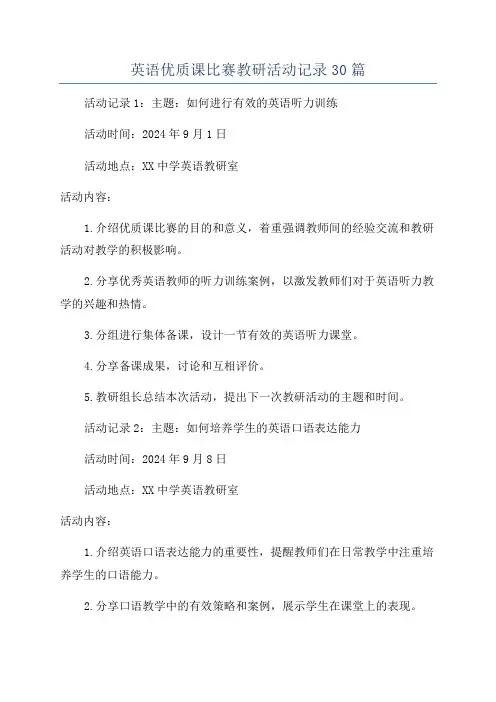
英语优质课比赛教研活动记录30篇活动记录1:主题:如何进行有效的英语听力训练活动时间:2024年9月1日活动地点:XX中学英语教研室活动内容:1.介绍优质课比赛的目的和意义,着重强调教师间的经验交流和教研活动对教学的积极影响。
2.分享优秀英语教师的听力训练案例,以激发教师们对于英语听力教学的兴趣和热情。
3.分组进行集体备课,设计一节有效的英语听力课堂。
4.分享备课成果,讨论和互相评价。
5.教研组长总结本次活动,提出下一次教研活动的主题和时间。
活动记录2:主题:如何培养学生的英语口语表达能力活动时间:2024年9月8日活动地点:XX中学英语教研室活动内容:1.介绍英语口语表达能力的重要性,提醒教师们在日常教学中注重培养学生的口语能力。
2.分享口语教学中的有效策略和案例,展示学生在课堂上的表现。
3.分组进行集体备课,设计一节能够培养学生口语表达能力的课堂活动。
4.分享备课成果,讨论和互相评价。
5.教研组长总结本次活动,鼓励教师们在日常教学中多多运用各种口语训练方法。
活动记录3:主题:利用多媒体教具进行英语词汇教学活动时间:2024年9月15日活动地点:XX中学英语教研室活动内容:1.介绍多媒体教具在英语词汇教学中的重要作用,强调了多媒体教学的优势和效果。
2.分享多种多媒体教具的使用方法和案例,包括词汇游戏、电子词典等。
3.分组进行集体备课,设计一节使用多媒体教具进行词汇教学的课堂。
4.分享备课成果,讨论和互相评价。
5.教研组长总结本次活动,鼓励教师们积极运用多媒体教具,提高词汇教学效果。
活动记录4:主题:如何激发学生学习英语的兴趣活动时间:2024年9月22日活动地点:XX中学英语教研室活动内容:1.介绍激发学生学习兴趣的重要性,分享相关理论和实践经验。
2.分享教师们在教学过程中激发学生学习兴趣的具体方法和策略。
3.分组进行集体备课,设计一节充满趣味和创意的英语课堂。
4.分享备课成果,讨论和互相评价。
第1篇一、活动背景随着我国英语教学改革的不断深入,英语教师的教学理念和方法也在不断更新。
为了提高英语教学质量,促进教师的专业发展,我校英语教研组于2023年3月15日开展了主题为“创新英语教学策略,提升学生英语素养”的研讨活动。
本次活动旨在通过集体研讨,探讨如何运用创新的教学策略,激发学生学习英语的兴趣,提升学生的英语综合素养。
二、活动时间及地点活动时间:2023年3月15日(星期三)下午2:00-5:00活动地点:学校多功能厅三、活动参与人员参与人员:英语教研组全体教师、学校领导、部分兄弟学校英语教师四、活动流程1. 开场致辞学校领导对本次研讨活动表示了高度重视,并对英语教研组提出了期望和要求。
2. 主题发言由教研组长王老师做主题发言,王老师结合自身教学经验,分享了“情境教学法在英语教学中的应用”的实践案例,并就如何创设有效的教学情境进行了深入剖析。
3. 分组研讨全体教师分为四个小组,围绕以下议题进行研讨:- 如何运用多媒体技术提高英语课堂教学效果?- 如何激发学生学习英语的兴趣?- 如何培养学生的英语口语表达能力?- 如何进行有效的英语教学评价?4. 小组汇报各小组分别汇报研讨成果,分享创新教学策略和经验。
5. 专家点评邀请了兄弟学校英语教研组长张老师对本次研讨活动进行点评,张老师对教研组的研讨成果给予了充分肯定,并提出了宝贵的意见和建议。
6. 总结发言教研组长王老师对本次研讨活动进行了总结,强调了创新教学策略的重要性,并对今后的英语教学工作提出了新的要求。
五、活动内容1. 情境教学法在英语教学中的应用王老师在主题发言中提到,情境教学法能够有效激发学生的学习兴趣,提高学生的英语实际运用能力。
她以“英语角”为例,详细介绍了如何创设真实的语言环境,让学生在情境中学习、运用英语。
2. 多媒体技术在英语教学中的应用小组一在研讨中提出,多媒体技术能够丰富教学内容,提高课堂教学的趣味性。
他们分享了利用PPT、视频、音频等多媒体资源进行英语教学的成功案例。
第1篇Date: March 15, 2023Location: School Library Conference RoomAttendees:- Mr. John Smith, Department Head- Ms. Jane Doe, Lead Teacher- Ms. Emily Johnson, Grade 7 Teacher- Mr. Michael Brown, Grade 9 Teacher- Ms. Sarah Lee, Grade 10 Teacher- Ms. Lisa Wang, Special Education Coordinator- Ms. Carol Chen, Library AssistantAgenda:1. Review of the current English curriculum2. Discussion on the integration of technology in English classes3. Sharing of innovative teaching methods4. Feedback on student performance and progress5. Planning for upcoming department events and professional development opportunitiesActivity Record:1. Review of the Current English CurriculumThe session began with a review of the current English curriculum by Mr. John Smith. He highlighted the key areas of focus for each grade level, including reading comprehension, writing skills, vocabulary, and grammar. The department discussed the effectiveness of the current curriculum and identified areas that needed improvement.Mr. John Smith:"Based on our observations, we've noticed that students are struggling with complex sentence structures and advanced vocabulary. We need to revisit our curriculum and ensure that it adequately prepares students for these challenges."Ms. Jane Doe:"I agree with John. We also need to ensure that our curriculum is aligned with the latest educational standards and that it promotes critical thinking and analytical skills."2. Discussion on the Integration of Technology in English ClassesThe next topic of discussion was the integration of technology in English classes. Ms. Emily Johnson shared her experience of using educational apps and online resources to enhance student engagement and learning outcomes.Ms. Emily Johnson:"I've been using the 'ReadWorks' platform to provide my students with a variety of reading materials. It's been great for improving their comprehension skills and expanding their vocabulary."Mr. Michael Brown:"Emily, that's fantastic! We should consider integrating more digital tools into our lessons. However, we need to be careful not to overuse technology and lose the personal touch of traditional teaching methods."3. Sharing of Innovative Teaching MethodsThe group then moved on to share innovative teaching methods that had been successful in their classrooms. Ms. Sarah Lee discussed the use of cooperative learning and group projects to promote collaboration and critical thinking.Ms. Sarah Lee:"I've found that when students work together on projects, they are more motivated and engaged. It also helps them to develop their teamwork and communication skills."Ms. Lisa Wang:"That's a great idea, Sarah. I think we should try to incorporate more group activities into our lessons. It would also benefit our special education students by providing them with more opportunities to interact with their peers."4. Feedback on Student Performance and ProgressThe department discussed the feedback received from students, parents, and colleagues regarding student performance and progress. Several teachers shared their observations and concerns.Mr. Michael Brown:"I've noticed that some students are consistently struggling with grammar and writing. We need to identify the root cause of this and provide targeted support."Ms. Sarah Lee:"I agree with Michael. We should conduct a diagnostic assessment to identify the specific areas where students are struggling and thentailor our instruction accordingly."5. Planning for Upcoming Department Events and Professional Development OpportunitiesThe final part of the meeting was dedicated to planning for upcoming department events and professional development opportunities. The group discussed several ideas, including a departmental book club, a guest speaker series, and a professional development workshop on "Incorporating Project-Based Learning in English Classes."Mr. John Smith:"I think these events will be great for fostering a sense of community within our department and providing us with opportunities to learn from each other. Let's make sure to promote these events to our colleagues and encourage their participation."Conclusion:The English department research and development activity was a productive and engaging session. The department identified key areas for improvement in the curriculum, discussed the benefits of technology integration, shared innovative teaching methods, and made plans for upcoming events and professional development opportunities. The collective efforts of the department will undoubtedly enhance thequality of English education at our school.Sign-off:All attendees agreed to the action points discussed during the meeting and committed to working together to implement the proposed changes. The next department meeting is scheduled for April 15, 2023.Attending Teachers' Signatures:- Mr. John Smith- Ms. Jane Doe- Ms. Emily Johnson- Mr. Michael Brown- Ms. Sarah Lee- Ms. Lisa Wang- Ms. Carol Chen第2篇Date: March 15, 2023Time: 9:00 AM - 4:00 PMLocation: School Library, Main CampusAttendees:- Mr. John Smith, Department Head- Ms. Emily Johnson, Lead Teacher- Mrs. Lisa Wang, Curriculum Coordinator- Mr. Michael Brown, Assistant Teacher- Mrs. Sarah Lee, Special Education Teacher- Ms. Lisa Davis, ESL Teacher- Ms. Angela Chen, LibrarianAgenda:1. Introduction of the Meeting2. Review of Current English Curriculum3. Discussion on Teaching Strategies and Challenges4. Introduction of New Resources and Technology5. Workshops on Grammar and Vocabulary Teaching6. Review of Student Performance and Feedback7. Planning for Upcoming School Year8. Open Forum9. Conclusion and Next Steps1. Introduction of the MeetingMr. John Smith, the Department Head, welcomed all attendees and outlined the objectives of the教研活动. He emphasized the importance of continuous improvement in teaching methods and the need forcollaborative efforts to enhance the English learning experience for all students.2. Review of Current English CurriculumMs. Emily Johnson, the Lead Teacher, presented an overview of thecurrent English curriculum. She highlighted the key components of the curriculum, including reading, writing, speaking, and listening skills. The group discussed the strengths and weaknesses of the current curriculum, focusing on areas where students seemed to struggle the most.3. Discussion on Teaching Strategies and ChallengesThe team engaged in a lively discussion about various teachingstrategies and the challenges they face in the classroom. Mrs. Lisa Wang, the Curriculum Coordinator, shared her insights on incorporating more interactive and project-based learning activities. Mr. Michael Brown,the Assistant Teacher, discussed the challenges of differentiating instruction to meet the diverse needs of students with varying English proficiency levels.4. Introduction of New Resources and TechnologyMs. Lisa Davis, the ESL Teacher, introduced new resources and technology that could be incorporated into the English curriculum. She showcased a variety of online platforms, educational apps, and interactive whiteboards that could enhance student engagement and learning outcomes. The group expressed enthusiasm about exploring these new tools and integrating them into their teaching practices.5. Workshops on Grammar and Vocabulary TeachingMrs. Sarah Lee, the Special Education Teacher, facilitated a workshop on effective grammar and vocabulary teaching strategies. She emphasized the importance of systematic instruction and provided practical tips for teaching complex grammar concepts and expanding students' vocabulary. The participants engaged in hands-on activities and shared their experiences and best practices.6. Review of Student Performance and FeedbackMs. Angela Chen, the Librarian, provided a comprehensive review of student performance data and feedback from recent assessments. Shehighlighted areas where students excelled and areas that requiredfurther attention. The team discussed potential interventions and strategies to address the identified challenges.7. Planning for Upcoming School YearThe group discussed the planning for the upcoming school year, focusing on the following areas:- Review and update of the English curriculum to ensure alignment with the latest educational standards.- Development of a comprehensive assessment plan to monitor student progress.- Implementation of new teaching strategies and resources.- Training for teachers on the use of technology and best practices in English instruction.8. Open ForumAn open forum was held to address any concerns or suggestions from the team. Several teachers expressed the need for more professional development opportunities and support for teachers who are teaching English as a second language. The Department Head assured the team that these concerns would be addressed and that additional resources would be allocated for professional development.9. Conclusion and Next StepsMr. John Smith concluded the meeting by summarizing the key points discussed and outlining the next steps. He emphasized the importance of collaboration and ongoing communication among the team. He assigned specific tasks to each member and set a deadline for the completion of these tasks.Next Steps:- Mr. John Smith will coordinate with the school administration to secure funding for professional development opportunities.- Ms. Emily Johnson will lead a committee to review and update the English curriculum.- Mrs. Lisa Wang will develop a comprehensive assessment plan and share it with the team for feedback.- Ms. Lisa Davis will conduct a workshop on the use of educational technology for all teachers.End of MeetingThe教研活动于下午4:00圆满结束。
第1篇一、活动时间2023年10月26日,星期四,下午2:00-5:00二、活动地点学校多功能厅三、活动主题“基于核心素养的英语阅读教学策略探讨”四、活动参与人员1. 英语教研组全体成员2. 外聘英语教学专家3. 其他年级英语教师五、活动流程1. 开场致辞(2:00-2:10)- 主持人介绍活动背景和目的,强调教研活动的重要性。
2. 专家讲座(2:10-3:10)- 外聘专家就“基于核心素养的英语阅读教学策略”进行专题讲座。
- 专家从以下几个方面展开讲解:1. 核心素养的内涵与英语阅读教学的关系2. 英语阅读教学的目标与策略3. 如何设计有效的阅读教学活动4. 如何评估阅读教学效果3. 课堂观摩(3:10-4:10)- 由教研组教师进行课堂展示,内容为“人教版小学英语四年级上册 Unit 4 My Home”。
- 观摩结束后,参与教师进行点评,分享教学心得。
4. 分组讨论(4:10-4:50)- 将教师分为三个小组,围绕以下主题进行讨论:1. 如何将核心素养融入英语阅读教学?2. 如何设计多样化的阅读教学活动?3. 如何评估阅读教学效果?- 每组推选一名代表进行总结发言。
5. 总结发言(4:50-5:00)- 主持人对本次教研活动进行总结,强调以下几点:1. 教师要树立核心素养意识,关注学生的全面发展。
2. 要不断探索有效的阅读教学策略,提高教学效果。
3. 要加强团队合作,共同促进英语教学质量的提升。
六、活动内容1. 专家讲座内容(1)核心素养的内涵与英语阅读教学的关系专家指出,核心素养是指学生在终身学习过程中形成的,适应个人终身发展和社会发展需要的必备品格和关键能力。
英语阅读教学是培养学生核心素养的重要途径,教师要关注学生的语言能力、文化意识、思维品质和学习能力等方面的发展。
(2)英语阅读教学的目标与策略专家强调,英语阅读教学的目标是提高学生的阅读理解能力、信息提取能力、语言运用能力和文化理解能力。
第1篇日期:[填写日期]地点:[填写地点]参与人员:[填写参与人员名单]主持人:[填写主持人姓名]记录人:[填写记录人姓名]一、活动背景[简要介绍本次教研活动的目的、意义和背景信息]二、活动内容1. [主题一]- 讲座/讨论主题:[填写主题]- 主讲人:[填写主讲人姓名]- 主要内容:[简要概述主讲人分享的内容,包括理论、案例、教学方法等] - 互动环节:[记录现场互动情况,如提问、讨论、意见交流等]2. [主题二]- 讲座/讨论主题:[填写主题]- 主讲人:[填写主讲人姓名]- 主要内容:[简要概述主讲人分享的内容]- 互动环节:[记录现场互动情况]3. [主题三]- 讲座/讨论主题:[填写主题]- 主讲人:[填写主讲人姓名]- 主要内容:[简要概述主讲人分享的内容]- 互动环节:[记录现场互动情况]三、活动总结1. [总结本次教研活动的亮点和收获]2. [提出改进建议和下一步工作计划]四、附件[如有相关资料、图片、视频等,可在此处列出][主持人签名][记录人签名][日期]第2篇日期:[具体日期]地点:[具体地点]参与人员:[参与教师名单]一、活动主题:[本次教研活动的主题,例如:探讨英语教学法新趋势]二、活动内容:1. 开场介绍- [主持人姓名]简要介绍本次教研活动的目的和意义。
2. 主题报告- [报告人姓名]就“[主题]”进行深入讲解,分享最新的教学法和研究进展。
3. 案例分享- [教师姓名]分享在教学实践中遇到的问题及解决方法,其他教师进行讨论和交流。
4. 分组讨论- 将教师分成小组,就以下问题进行讨论:- [讨论问题1]- [讨论问题2]- [讨论问题3]- 各小组汇报讨论成果。
5. 总结与反思- [主持人姓名]对本次教研活动进行总结,强调活动中的亮点和不足,并提出改进建议。
三、活动成果:1. 教师们对[主题]有了更深入的了解。
2. 发现并解决了教学中的一些实际问题。
3. 提升了教师的团队协作能力和教研能力。
英语教研活动记录12篇英语教研活动记录12篇英语教研活动记录(一):活动时光:xx年10月29日活动地点:班级教室项目名称:英语教研活动项目负责人:xx活动主题:公开课主讲人:xx参加对象:部分教师活动资料及进程:三位教师在本次的校级英语教研活动中,每人上了一节校级公开课。
课后三位教师都详细的阐述了自我的教学设计。
课后交流的过程中,听课教师都发表了意见及看法。
活动反思与提议:英语学科的教师较少,课堂教学研讨的形式就显得单一,同时活动的主题尚未构建,在以后的活动中能够从学校的教学实际、学生的学习实际出发构建一个主题,围绕主题开展研讨,或许会更有效果。
英语教研活动记录(二):活动资料:评课主持人:宋燿天活动时光:60分钟活动地点:办公室参加人员:全体英语教师活动资料:期末将至,最近我们教研组几位教师都完成了教研组公开课。
今日就陈玉教师的公开课,进行了热烈地探讨。
很多时候,评课的时候常常离题万里,天马行空地聊了开去。
往往在评一个教师的课时,话题会迁移到另外一个教师的教学环节的设计与处理上去;在评课的时候也不断产生并抛出话题,引起各位教师的共鸣与探讨。
这样的漫无主题,其实是更深层次的研讨;这样的游离主题,其实是更深刻地研讨。
叶文教师:这节课设计大胆、新颖,创意十分好。
教师对教材重、难点的把握比较扎实。
陆建华教师:这节课中背景图片都是日常的生活场景,十分有亲切感,能够激发学生学习兴趣。
宋燿天教师:陈教师的教学设计每次都有其独特之处,除了能够显示教师的教学本事,也能够体现教师的教学创新意识和本事。
教学永远没有最好的方法,仅有最适合的方法。
陈教师的教学理念,十分有时代气息。
在课堂教学中十分重视口语练习,着重学生口语交际本事的培养。
坚持下去对学生是十分有好处的。
课堂教学中,难点处理得十分好。
喻丽娟教师:练习题形式十分好,触类旁通,给我自我教学中产生了新的思路。
以后我在自我的教学中也采取类似的方案。
这节课总的比较好,无论教学重、难点的把握,还是教学过程的设计,都比较到位。
英语教研活动记录优选12篇【导语】英语教研活动记录优选12篇由***整理投稿精心推荐,我希望对你的学习工作能带来参考借鉴作用。
【目录】篇1:英语教研活动记录篇2:英语教研活动记录篇3:英语教研活动记录篇4:英语教研活动记录篇5:英语教研活动记录篇6:英语教研活动记录篇7:英语教研活动记录篇8:英语教研活动记录篇9:英语教研活动记录篇10:英语教研活动记录篇11:英语教研活动记录篇12:英语教研活动记录【正文】篇1:英语教研活动记录活动时光:20xx年10月29日活动地点:班级教室项目名称:英语教研活动项目负责人:xxx活动主题:公开课主讲人:xxx参加对象:部分教师活动资料及进程:三位教师在本次的校级英语教研活动中,每人上了一节校级公开课。
课后三位教师都详细的阐述了自我的教学设计。
课后交流的过程中,听课教师都发表了意见及看法。
活动反思与提议:英语学科的教师较少,课堂教学研讨的形式就显得单一,同时活动的主题尚未构建,在以后的活动中能够从学校的教学实际、学生的学习实际出发构建一个主题,围绕主题开展研讨,或许会更有效果。
篇2:英语教研活动记录活动资料:评课主持人:宋燿天活动时光:60分钟活动地点:办公室参加人员:全体英语教师活动资料:期末将至,最近我们教研组几位教师都完成了教研组公开课。
今日就陈玉教师的公开课,进行了热烈地探讨。
很多时候,评课的时候常常“离题万里”,天马行空地聊了开去。
往往在评一个教师的课时,话题会迁移到另外一个教师的教学环节的设计与处理上去;在评课的时候也不断产生并抛出话题,引起各位教师的共鸣与探讨。
这样的“漫无主题”,其实是更深层次的研讨;这样的“游离主题”,其实是更深刻地研讨。
叶文教师:这节课设计大胆、新颖,创意十分好。
教师对教材重、难点的把握比较扎实。
陆建华教师:这节课中背景图片都是日常的生活场景,十分有亲切感,能够激发学生学习兴趣。
宋燿天教师:陈教师的教学设计每次都有其独特之处,除了能够显示教师的教学本事,也能够体现教师的教学创新意识和本事。